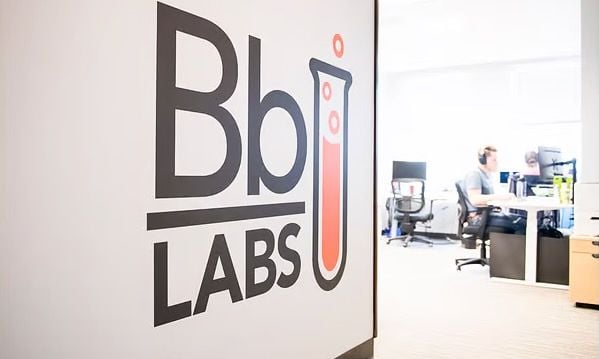No one wants to be “PowerPointed to death.”
This is something BombBomb Chief Operating Officer Nicole Craine knows well. She remembers what it was like when many companies required their new hires to watch hours of presentations in a stuffy conference room.
Over the years, Craine has seen onboarding processes change as more organizations embrace a mix of lectures with hands-on, self-paced integration and moments for connection. She believes this approach creates more impactful outcomes.
“New employees who feel like their company and manager are excited, prepared and ready to invest in their success makes all the difference long term,” Craine said. “The first 100 days are critical.”
At BombBomb, a company that enables individuals and businesses to record, send and track video messages, new hires’ first 100 days are filled with support and, most importantly, relationship building.
Before a new hire’s first day, Talent Acquisition Manager Matt Sowin sends each one a video — using the company’s video messaging platform, of course — to introduce himself and give them an idea of what to expect.
“This human touch not only showcases the product they’ll be working to support, but also starts to build those real human relationships, as most of our new hires are remote,” Sowin said.
Senior Customer Care Manager Jason Phillips added that these gestures of community are key to the company’s culture and its approach to the onboarding process.
“Joining any company is always overwhelming and can be intimidating,” Phillips said. “It’s worth investing time and resources into making this experience great.”
Through a combination of thoughtful programming, integrative tools and one-on-one support, BombBomb enables new hires to begin growing their careers at the company as quickly and effectively as possible.

The First 100 Days — and Beyond
Onboarding at BombBomb involves more than an exciting swag package — although there’s that, too.
To get orientation started, Craine explained, each new team member creates a video using the company’s platform to share information about themselves and their background, which is shared with the wider organization.
But the introductions don’t stop there.
Besides receiving a flurry of kind Slack messages from their colleagues, new hires take part in a game during a monthly all-hands meeting, where they answer questions about themselves.
For the first couple of days of orientation, new hires complete assessments through BombBomb’s onboarding platform, NorthPass. Phillips said many new team members will also shadow their peers for a couple of weeks to understand the nuances of their role, which is typically facilitated by a manager or lead in their given department.
The company knows that there’s a lot of information to digest during this time, which is why each new hire is paired with an onboarding buddy who serves as a go-to guide during their first few weeks on the job. Another guide for the new hire is the 30/60/90 plan they develop with their manager, which is tailored to their specific department’s processes and systems.
To top it off, Sowin noted that every new hire meets one on one with leaders and peers throughout the first few weeks. Team members will often take the initiative and reach out to onboarding employees to set up time to chat.
Sowin believes that BombBomb’s approach to onboarding rejects “by-the-book” strategies. It’s essential for the company to think about new hires more holistically, especially given the social constraints that come with remote work.
“You can’t build relationships and learn about the company as organically as you once could by bumping into teammates in the break room,” Sowin said. “We have to be much more intentional about setting aside time to spend with new hires to share institutional knowledge and prepare them for success.”
“We have to be much more intentional about setting aside time to spend with new hires to share institutional knowledge and prepare them for success.”
Once a new hire’s first 100 days have ended, the support that brought them there remains, taking the form of a robust six-week mentorship program accessible for all employees. Sowin explained that the program, which began several years ago, was designed to make it easier for employees to learn from their peers in a structured, accessible setting.
“The goal of our program was to remove some of the barriers and help these connections be made,” he said.
Sowin has participated in the program as both a mentor and mentee. While he has helped other employees navigate certain topics, such as work-life balance and organization skills, he has also found support from a data and analytics leader through the program.
“Throughout both of these experiences, I was able to strengthen pre-existing relationships, gain actionable skills and grow,” Sowin said.
GROW ON YOUR OWN TERMS
The best growth is the kind that happens on one’s own terms, which is why BombBomb offers its employees a $1,000 professional development stipend, which can put toward any educational opportunity they choose. Sowin has used the stipend to become a certified DEI recruiter and obtain a Google Data Analytics certification. Craine has leveraged the stipend to participate in a peer group, where she gets to walk through challenges and work through solutions with support from others.
Given the evolution he’s witnessed among his colleagues, Sowin believes the company’s growth stipend is one of the organization’s most impactful offerings. “Over my time at BombBomb, I’ve seen tremendous growth of our employees being promoted into new roles and moving onto new teams — and often their ability to do so has come at least in part from this professional development program,” he said.

Set up for Success
At BombBomb, onboarding is about more than giving individuals the tools they need to perform in their role. In Sowin’s mind, this orientation period can define how employees impact the company now — and long term.
“We know how a robust onboarding experience can lead to stronger performance and even tenure of our employees, which is why we are constantly reviewing and iterating on that onboarding experience,” he said.
For this reason, the company discusses new hires’ scorecards, which outline their job responsibilities and expectations, during the onboarding process. This ultimately ties back directly into employee evaluations and reviews throughout the year.
“Being clear about these goals and expectations early on helps that employee make the impact they want to,” Sowin explained.
“Being clear about goals and expectations early on helps that employee make the impact they want to.”
For Sowin, running a successful onboarding experience isn’t about staying close to guidelines and structure — it’s about shirking the status quo.
“Don’t be afraid to try new things,” he said. “They won’t always work, but often you can learn from them and make other improvements that may accomplish what you are looking for.”
While there are many factors that go into an onboarding program, Sowin believes there’s one essential element that stands above the rest: peer-to-peer connection.
“Any time you can add a human touch to a new hire’s experience, especially if they’re hybrid or remote, it will help them feel more connected more quickly,” he said. “It can be hard to build relationships with a new team member in a remote environment, so being intentional about it can really help them get integrated into your team and have them become successful quickly.”








